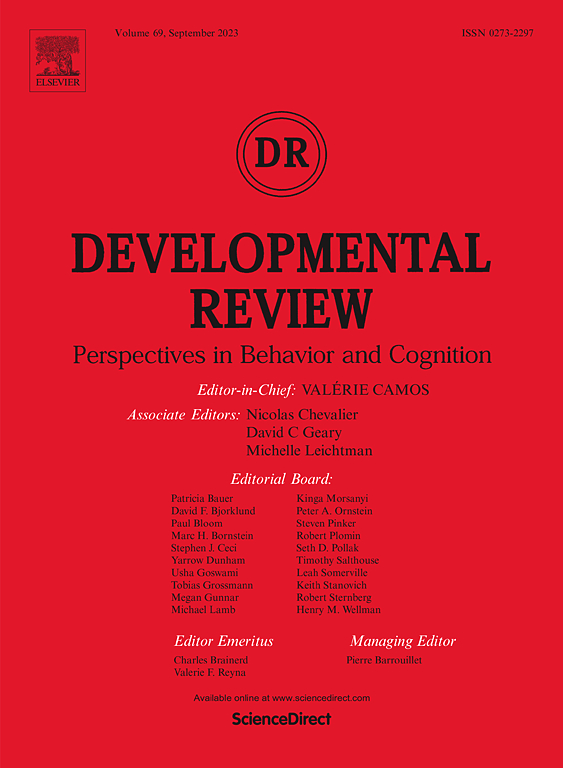Integrating attention, working memory, and word learning in a dynamic field theory of executive function development: Moving beyond the ‘component’ view of executive function
IF 5.6
1区 心理学
Q1 PSYCHOLOGY, DEVELOPMENTAL
引用次数: 0
Abstract
Executive functions (EFs) are core cognitive abilities that enable self-control and flexibility. EFs undergo transformational changes between 3 to 5 years of age; critically, individual differences in these abilities are predictive of longer-term outcomes. Thus, a key question is how EFs change in early development. This question is complicated by evidence that EFs are supported by attentional, inhibitory, working memory, and task switching processes, ‘component’ abilities which themselves change over time. Thus, understanding the early development of EFs requires a framework for understanding how attention, working memory, and other abilities develop and how they are integrated to enable new EF skills. Here, we take a theory-based approach to this problem, building a neural process model that integrates multiple neurocognitive processes together and grounds these processes in perception–action dynamics. We then explore how EFs emerge from these integrated processes over development. In particular, we extend prior work showing how the concepts of dynamic field theory explain the emergence of EFs in the dimensional change card sort (DCCS) task by integrating our theory of EF with a new model of visual exploration and word learning (WOLVES). This integration (WOLVES 2.0) specifies how visual-spatial attention, visual working memory, auditory-visual word representations, and top-down attention mechanisms come together to enable EFs from 3 to 5 years. Our central hypothesis is that children learn autonomous self-control by using language to guide attention to key features of the world in context. We demonstrate this, showing how, for example, children’s learning of individual colour words and the associations among colour words and the word ‘colour’ gradually enable dimensional attention. More generally, we use WOLVES 2.0 as a concrete framework to explore how the concept of executive functions can be moved beyond the ‘component’ view towards a developmental systems perspective.
在执行功能发展的动态领域理论中整合注意力、工作记忆和单词学习:超越执行功能的“组成部分”观点
执行功能(EFs)是实现自我控制和灵活性的核心认知能力。儿童在3至5岁之间发生转变;至关重要的是,这些能力的个体差异可以预测长期结果。因此,关键问题是EFs在早期发育中是如何变化的。有证据表明,电磁场受到注意力、抑制、工作记忆和任务转换过程的支持,这些“组成”能力本身会随着时间的推移而变化,这使问题变得复杂。因此,理解EF的早期发展需要一个框架来理解注意力、工作记忆和其他能力是如何发展的,以及它们是如何整合成新的EF技能的。在这里,我们采取基于理论的方法来解决这个问题,建立一个神经过程模型,将多个神经认知过程整合在一起,并将这些过程置于感知-行动动力学中。然后我们将探讨EFs是如何在开发过程中从这些集成过程中产生的。特别是,我们扩展了之前的工作,通过将我们的EF理论与视觉探索和单词学习的新模型(WOLVES)相结合,展示了动态场理论的概念如何解释维度变化卡排序(DCCS)任务中EF的出现。这种集成(WOLVES 2.0)规定了视觉空间注意、视觉工作记忆、听觉视觉单词表征和自上而下的注意机制如何结合在一起,以实现3到5年的ef。我们的中心假设是,儿童通过使用语言来引导人们注意世界的关键特征,从而学会自主自我控制。我们对此进行了论证,例如,儿童如何学习单个颜色单词以及颜色单词与“颜色”之间的联系,从而逐渐提高维度注意力。更一般地说,我们使用狼群2.0作为一个具体的框架来探索如何将执行功能的概念从“组件”的观点转移到发展系统的观点。
本文章由计算机程序翻译,如有差异,请以英文原文为准。
求助全文
约1分钟内获得全文
求助全文
来源期刊

Developmental Review
PSYCHOLOGY, DEVELOPMENTAL-
CiteScore
11.00
自引率
3.00%
发文量
27
审稿时长
51 days
期刊介绍:
Presenting research that bears on important conceptual issues in developmental psychology, Developmental Review: Perspectives in Behavior and Cognition provides child and developmental, child clinical, and educational psychologists with authoritative articles that reflect current thinking and cover significant scientific developments. The journal emphasizes human developmental processes and gives particular attention to issues relevant to child developmental psychology. The research concerns issues with important implications for the fields of pediatrics, psychiatry, and education, and increases the understanding of socialization processes.
 求助内容:
求助内容: 应助结果提醒方式:
应助结果提醒方式:


